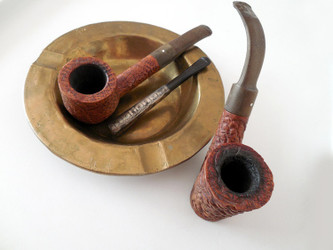Most pipe smokers are easy-going folks who enjoy nothing more than sitting back, firing up a bowl of their favorite tobacco, and binge-watching their favorite show, or maybe even - gasp! - reading a book. But if you want to get these often taciturn individuals riled up just ask them what they think about bowl coatings. Purists tend to believe bowl coatings represent a serious form of blasphemy, right up there with tobacco casings. Others, however, appreciate that the coatings can give them a head start on creating the much sought-after "cake" for their tobacco pipes. But no matter which side of the coating divide you come down on we’ve got everything you need to know about the practice right here.
What Are Bowl Coatings?
First off, let’s get one thing out of the way: neither meerschaum pipes nor clay pipes have bowl coatings. Bowl coatings are the exclusive domain of the briar pipe. Bowl coatings are not tobacco pipe accessories either, in that you cannot install or remove them like you can screens.
That said, bowl coatings are exactly what they sound like: coatings applied to the bowls of tobacco pipes. Not all briar pipes have them. In fact, until relatively recently a majority did not have bowl coatings. Instead, the outside of the bowl was coated to seal the wood against the elements while the wood inside the bowl was left exposed. Over the past couple of decades, coatings have become a favorite of high volume brands like Peterson, which is likely why they are now in the majority.
Coatings come in two forms; organic and nonorganic. Let’s take a look at them.
The Organic Bowl Coating
Among briar pipes with coated bowls, the more expensive ones tend to have this type of coating. The organic coating is a mixture of charcoal and carbon powder mixed with a binder such as egg white or honey. Most people, even those who are long-time fans of bowl coatings, say that this type of coating is undetectable. That is, it does not affect the flavor of the tobacco in any way. Coating opponents will sometimes disagree, but even they will acknowledge that of the two different types of coating, organic ones are the least objectionable.
The Nonorganic Bowl Coating
If organic bowl coatings are so unobtrusive why would anyone use anything else? One word: cost. Organic coatings are more expensive than non-organic coatings, and since pipe making is a business and most businesses are focused on keeping costs down… well, you get the picture.
The nonorganic coating is sometimes referred to as a “waterglass" coating. It's comprised of a chemical solution mixed with powdered carbon. The mixture is then painted onto the inside of the bowl where it's supposed to provide protection from overzealous pipe smokers and give a head start on the cake. Despite the cost savings nonorganic bowl coatings are gradually falling out of favor due to their alleged tendency to alter the taste of tobacco and to undermine the performance of the briar pipe.
The Benefits of Coating Tobacco Pipes
Most large scale pipe manufacturers are applying bowl coatings these days and not because they look good, but because of their reputed ability to:
Protect the bowl - New pipe smokers have a tendency to draw too aggressively on the pipe. This can undermine the integrity of the bowl and shorten the life of the pipe. The bowl coating is supposed to help protect the bowl from this type of damage.
Help jump start cake formation - The cake is the accumulation of carbon deposits left behind in tobacco pipes by the smoking process. These deposits insulate the bowl, help protect it from charring, and generally make the smoking experience sweeter and more pleasant. Bowl coatings are supposed to give you a leg up on cake creation.
Make the pipe cooler to hold - It is alleged by some that the bowl coating helps keep the outside of the bowl a bit cooler than it would be without a coating. And that makes sense since the coating adds a bit more insulation between combustion in the chamber and the briar wood.
Why People Object To Bowl Coatings
There are numerous reasons why some pipe aficionados object to bowl coatings, and we alluded to some of them already. But the biggest issue seems to be that the anti-coaters think that bowl coatings are being used to mask imperfections in briar pipes.
While there may be some instances where this is the case, the greater truth is that bowl coatings, when done right, can add value to the product and "value added" is a phrase that is music to most manufacturers' ears. The notion that pipe makers are engaged in some kind of briar conspiracy to mask the flaws in their product seems a bit far-fetched, considering the practical benefits coatings can provide. Also, trying to hide flaws in such a way is bound to fail in the long run. Eventually, someone would be able to provide irrefutable proof of any deception and the pipe maker's reputation would be ruined.
Conclusion
It’s pretty widely accepted that nonorganic bowl coatings can sometimes alter the smoking experience (to what degree depends on who you talk to). However, bowl coatings in general should not be considered a bad thing.
Whether you’re looking for a coated pipe or uncoated wholesale tobacco pipes Paykoc Pipes is your best bet for quality, price and customer service.

 US Dollars
US Dollars
